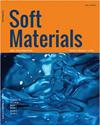用于可持续储能的软组装生物凝胶电解双层电容器系统
IF 1.4
4区 材料科学
Q4 MATERIALS SCIENCE, MULTIDISCIPLINARY
引用次数: 1
摘要
卡拉胶是一种有吸引力的生物衍生聚合物电解质,因为它具有高的离子导电性、循环稳定性和与聚乙烯醇(PVA)等其他生物相容性聚合物共聚的成本效益。本文讨论了生物电解质的物理和化学性质:PVA、卡拉胶和PVA-卡拉胶共聚物共混物。我们还描述了一种使用PVA-卡拉胶聚合物混合物制造软印刷薄膜生物凝胶电解双层电容器(bio-EDLC)的制造方法。将PVA添加到卡拉胶中为生物聚合物提供了结构和机械稳定性,使用衰减傅立叶变换红外光谱分析检测到的氢键证实了这一点。分析了组装的生物EDLC的电学性质,包括内部电荷转移机制、击穿、比电容、功率密度和能量密度。经测定,生物EDLC的比电容为84F/g,功率密度为4.15E-02W/kg,对生物EDLC进行了初步优化,在电极/电解质界面处滴注还原的氧化石墨烯,以产生表面微粗糙度,从而形成生物EDLC系统,该系统表现出优异的电气特性,总比电容高达118F/g,击穿电压约为1.3V,最大充电能力提高到80%。本文章由计算机程序翻译,如有差异,请以英文原文为准。
Soft-assembled, bio-gel electrolytic double layer capacitor system for sustainable energy storage
ABSTRACT Carrageenan is an attractive bio-derived polymer electrolyte due to its high ionic conductivity, cyclic stability, and cost-effectiveness in copolymerizing with other biocompatible polymers such as polyvinyl alcohol (PVA). This paper discusses the physical and chemical characterizations of the bio-electrolyte(s): PVA, carrageenan, and PVA-carrageenan copolymer blend. We also describe a fabrication method to create a soft-printed, thin-film, bio-gel electrolytic double-layer capacitor (bio-EDLC) using a PVA-carrageenan polymer blend. The addition of PVA to carrageenan provided structural and mechanical stability to the biopolymer, as confirmed by the hydrogen bonds detected using attenuated Fourier-transform infrared spectroscopy analysis. The assembled bio-EDLCs were analyzed for their electrical properties including their internal charge transfer mechanism, electrical breakdown, specific capacitance, power density, and energy density. It was determined that the bio-EDLC offers specific capacitance of 84 F/g and power density of 4.15E-02 W/kg and has a breakdown voltage of ~1.1 V. Furthermore, preliminary optimization was performed on the bio-EDLC with a drop casting of reduced graphene oxide at the electrode/electrolyte interface to create surface micro-roughness resulting in a bio-EDLC system which demonstrated superior electrical characteristics with an overall specific capacitance of up to 118 F/g, breakdown voltage of ~1.3 V, and improved maximum charging capability to 80%.
求助全文
通过发布文献求助,成功后即可免费获取论文全文。
去求助
来源期刊

Soft Materials
工程技术-材料科学:综合
CiteScore
2.90
自引率
0.00%
发文量
21
审稿时长
2.2 months
期刊介绍:
Providing a common forum for all soft matter scientists, Soft Materials covers theory, simulation, and experimental research in this rapidly expanding and interdisciplinary field. As soft materials are often at the heart of modern technologies, soft matter science has implications and applications in many areas ranging from biology to engineering.
Unlike many journals which focus primarily on individual classes of materials or particular applications, Soft Materials draw on all physical, chemical, materials science, and biological aspects of soft matter. Featured topics include polymers, biomacromolecules, colloids, membranes, Langmuir-Blodgett films, liquid crystals, granular matter, soft interfaces, complex fluids, surfactants, gels, nanomaterials, self-organization, supramolecular science, molecular recognition, soft glasses, amphiphiles, foams, and active matter.
Truly international in scope, Soft Materials contains original research, invited reviews, in-depth technical tutorials, and book reviews.
 求助内容:
求助内容: 应助结果提醒方式:
应助结果提醒方式:


